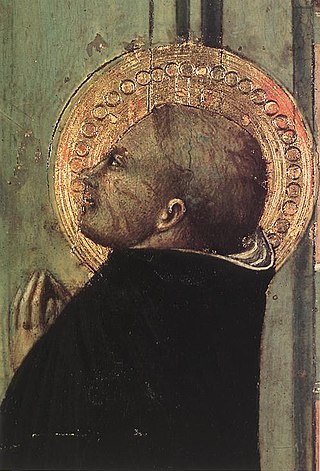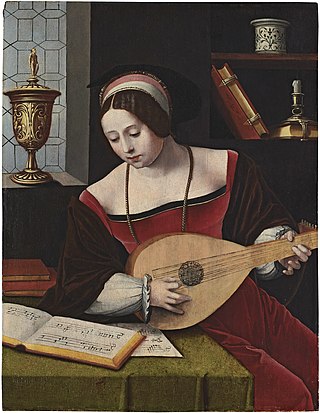
Paul Cézanne was a French artist and Post-Impressionist painter whose work introduced new modes of representation and influenced avant garde artistic movements of the early 20th century. Cézanne is said to have formed the bridge between late 19th-century Impressionism and the early 20th century's new line of artistic enquiry, Cubism.

Aix-en-Provence, or simply Aix, is a city and commune in southern France, about 30 km (20 mi) north of Marseille. A former capital of Provence, it is the subprefecture of the arrondissement of Aix-en-Provence, in the department of Bouches-du-Rhône, in the region of Provence-Alpes-Côte d'Azur. The population of Aix-en-Provence is approximately 145,000. Its inhabitants are called Aixois or, less commonly, Aquisextains.

Renaissance art is the painting, sculpture, and decorative arts of the period of European history known as the Renaissance, which emerged as a distinct style in Italy in about AD 1400, in parallel with developments which occurred in philosophy, literature, music, science, and technology. Renaissance art took as its foundation the art of Classical antiquity, perceived as the noblest of ancient traditions, but transformed that tradition by absorbing recent developments in the art of Northern Europe and by applying contemporary scientific knowledge. Along with Renaissance humanist philosophy, it spread throughout Europe, affecting both artists and their patrons with the development of new techniques and new artistic sensibilities. For art historians, Renaissance art marks the transition of Europe from the medieval period to the Early Modern age.

Saluzzo is a town and former principality in the province of Cuneo, in the Piedmont region, Italy.

The German Renaissance, part of the Northern Renaissance, was a cultural and artistic movement that spread among German thinkers in the 15th and 16th centuries, which developed from the Italian Renaissance. Many areas of the arts and sciences were influenced, notably by the spread of Renaissance humanism to the various German states and principalities. There were many advances made in the fields of architecture, the arts, and the sciences. Germany produced two developments that were to dominate the 16th century all over Europe: printing and the Protestant Reformation.

French art consists of the visual and plastic arts originating from the geographical area of France. Modern France was the main centre for the European art of the Upper Paleolithic, then left many megalithic monuments, and in the Iron Age many of the most impressive finds of early Celtic art. The Gallo-Roman period left a distinctive provincial style of sculpture, and the region around the modern Franco-German border led the empire in the mass production of finely decorated Ancient Roman pottery, which was exported to Italy and elsewhere on a large scale. With Merovingian art the story of French styles as a distinct and influential element in the wider development of the art of Christian Europe begins.

For the village near Livorno, see Sassetta, Tuscany

Albanian art refers to all artistic expressions and artworks in Albania or produced by Albanians. The country's art is either work of arts produced by its people and influenced by its culture and traditions. It has preserved its original elements and traditions despite its long and eventful history around the time when Albania was populated to Illyrians and Ancient Greeks and subsequently conquered by Romans, Byzantines, Venetians and Ottomans.

The Marquisate of Saluzzo was a historical Italian state that included parts of the current region of Piedmont and of the French Alps. The Marquisate was much older than the Renaissance lordships, being a legacy of the feudalism of the High Middle Ages.

Celle di Macra is a comune (municipality) in the Province of Cuneo, region of Piedmont, Italy. It is located about 80 kilometres (50 mi) southwest of Turin and about 30 kilometres (19 mi) northwest of Cuneo. At the end of 2017 it had a population of 94.

Elva is a comune (municipality) in the Province of Cuneo in the Italian region Piedmont, located about 80 kilometres (50 mi) southwest of Turin and about 40 kilometres (25 mi) northwest of Cuneo.

The Diocese of Saluzzo is a Catholic ecclesiastical territory in the Piedmont region of northwestern Italy, centered in the comune of Saluzzo. The diocese was established on 29 October 1511 for political reasons, to transform the Marquisate of Saluzzo into an ecclesiastic territory, and was directly dependent upon the Holy See. It is now a suffragan of the Archdiocese of Turin.

Barthélemy d'Eyck, van Eyck or d' Eyck, was an Early Netherlandish artist who worked in France and probably in Burgundy as a painter and manuscript illuminator. He was active between about 1440 to about 1469. Although no surviving works can be certainly documented as his, he was praised by contemporary authors as a leading artist of the day, and a number of important works are generally accepted as his. In particular, Barthélemy has been accepted by most experts as the artists formerly known as the Master of the Aix Annunciation for paintings, and the Master of René of Anjou for illuminated manuscripts. He is thought by many to be the Master of the Shadows responsible for parts of the calendar of the Très Riches Heures du Duc de Berry.

The Master of the Female Half-Lengths is the notname given to a painter, or more likely a group of painters of a workshop, active in the Low Countries in the early sixteenth century. The name was given in the 19th century to identify the maker or makers of a body of work consisting of 67 paintings to which since 40 more have been added. The Master created female figures in genre scenes, small religious and mythological works, landscapes and portraits.

Bartolomeo di Giovannidi Domenico was an Italian Renaissance painter active in Florence. His works were first identified by the art historian Bernard Berenson, who did not know the painter's real name so called him the "Alunno di Domenico". This name was based on Berenson's observation that the painter executed the predella of Ghirlandaio's Adoration of the Magi (1488) in the Ospedale degli Innocenti, the foundling hospital in Florence. Archival research later yielded the painter's real name as Bartolomeo di Giovanni. Bartolomeo also collaborated with Sandro Botticelli.

Trophime Bigot (1579–1650), also known as Théophile Bigot, Teofili Trufemondi, the Candlelight Master, was a French painter of the Baroque era, active in Rome and his native Provence.

Jacopo Ripanda was an Italian painter of the Renaissance era.
Engarandus Juvenis, "Enguerrand the Younger" is a composer, presumed to be of French origin, whose three known works are all preserved in a single codex in the Cistercian monastery of Staffarda, Italy. He is notable as the composer of the earliest surviving example of a polyphonic setting of a Requiem mass complete with Dies Irae section.
The Ferdinando Marinelli Artistic Foundry is one of the last remaining Florentine foundries, producing works in bronze utilizing the Renaissance technique of lost-wax. A large number of bronze sculptures produced in Florence over the last century come from this artistic foundry. One of the most famous and popular works in Florence, the 'La Fontana del Porcellino', was cast by the Marinelli Foundry in 1988 and replaced the antique in 1998.

The Franco-Savoyard War of 1600-1601 was an armed conflict between the Kingdom of France, led by Henry IV, and the Duchy of Savoy, led by Charles Emmanuel I. The war was fought to determine the fate of the former Marquisate of Saluzzo, and ended with the Treaty of Lyon which was favorable to France.


















